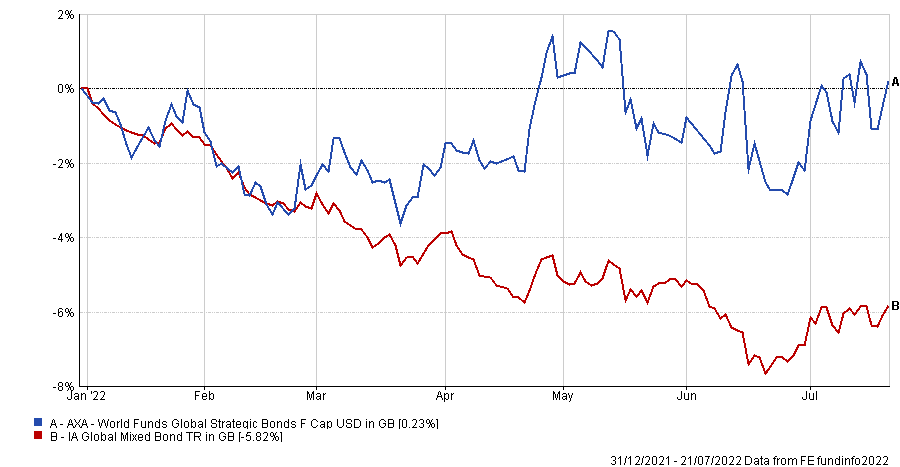Bonds have suffered the worst start to a year in 50 years, yet investors might start ploughing back into fixed income in the coming months if yields remain as high as they are now, according to AXA’s Nick Hayes.
The co-manager of the AXA World Funds Global Strategic Bonds fund, among others, said that while the first half of the year had been “horrendous”, there are signs that things are improving.
The first six months of 2022 hit the bond market hard, with inflation running rampant. As a result, central banks fell “behind the curve” and have had to move off zero interest-rate policies.
Throw in the commodity crisis caused by the Russia-Ukraine war and you have a perfect storm for the asset class but looking to the future there are signs that investors have become overcautious.
“Take Treasuries, which are pricing in around 3.5% to 4% interest rates in this cycle, which I think is a lot. Likewise in the UK, the bond yield is pricing in that we will see way more hikes than many economists suggest,” said Hayes.
In both countries, the Federal Reserve and Bank of England have been aggressive, hiking rates from the end of last year and beginning of this year respectively.
This monetary policy is designed to lower inflation, but is also likely to lead to lower economic growth, as consumer spending is reduced by higher mortgage repayments and already higher prices.
The end goal is a ‘soft landing’ where the growth rate and inflation both slow gradually. “This is good for fixed income,” said Hayes.
However, if they are not successful in creating a soft landing, then we could enter a recession, which he said should also be a positive environment for bonds.
“You have a market that is priced very attractively because it is factoring in a lot of inflation and interest rate rises. At the same time you have central banks trying to ferociously gain back credibility but to do that they will raise rates, which leads to a scenario where there is a higher probability of slower growth and inflation,” he said.
“That all points to a much better environment for fixed income, although whether that happens today, in three months or in six months, is anyone’s guess.”
Invesco Bond Income Plus investment trust manager Rhys Davies agreed, noting that at the current level of credit spreads and overall yield, “an actively managed allocation to high yield bonds offers an attractive opportunity for income and total return”.
Looking at the market in more detail, Hayes said that the macroeconomic environment should benefit government bonds, which according to data from Deutsche Bank have not had a worse start to the year since 1788.
But there are more opportunities in credit, he argued, with some short-dated high-quality investment grade bonds that yield 4%. “We haven’t seen that for years,” he said.
Similarly, the manager said he can buy A-rated, slightly longer-dated, bank or insurance debt that are yielding 6%-7%.
“That is what you are supposed to be able to get over the long term in equities,” he noted, meaning that “you don’t have to take as much risk to get super returns if you take a super long-term view, assuming that investment grade companies don’t default”.
An area he has avoided however is the high yield and low-quality investment grade parts of the market, which have sold off, but perhaps by not as much as they should.
“When we look at how far those spreads have sold off (or to put it another way how many defaults are priced into high yield or low-quality investment grade) it is nowhere near as bad as 2008 or the 2013 European crisis,” he said.
“I think some of high yield and lower investment grade have had a tough year-to-date, but it could get worse. It has not potentially priced in as much weaker earnings or default levels.”
He has employed this strategy and allocation decision well within his funds so far this year. Overall, of the six portfolios he co-manages, just one is in the bottom quartile of its sector, which four are in the top quartile including the AXA World Funds Global Strategic Bonds fund, which is the largest in his range.
Total return of fund vs sector over YTD

Source: FE Analytics
Yet although his funds have fared well, he argued that if investors can take a medium-term view of one to two years, the valuation argument looks “compelling”.
The basic principals of bonds are that if a company doesn’t default the person owning the bond will receive the price initially paid – referred to as a value of 100
“In the global aggregate benchmark, which has 50%-60% in government bonds and 40% in credit, the average price is now in the mid-to-low 90s, which has come down from 110-115,” said Hayes.
“So just from owning that basket of bonds you have a decent yield and a pull to par effect where the cash price is below 100 so there is also a capital appreciation argument.”
“It is not fashionable, but fixed income has gone through a seismic repricing from a world of low yields where no one liked to high yields. The time to buy fixed income is when there is yield and spread, and we have both on offer.”





